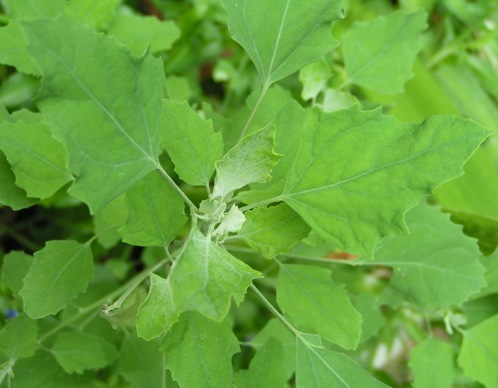
[social_buttons]
“The salad is bitter this year.”
My daughter is referring to the lambsquarter (Chenopodium album). I pull a leaf from the waist-high plant and taste it. She’s right; it’s bitter. We usually eat the lambsquarter raw, but today I’ll need to cook it before she decides to never eat it again.
Sometimes referred to as goosefoot or pigweed (and sometimes spelled lamb’s quarter), this wild relative of spinach and quinoa has been eaten by people for thousands of years. High in vitamins A and C, and with a sprinkling of B vitamins and several minerals, lambsquarter is an excellent green for the health-conscious — and for growing kids.
My daughter likes to forage for food in our backyard. To her mind, it’s an adventure every time. From my perspective, it’s a way to get her excited about vegetables. She hears the other kids in the neighborhood talk about refusing to eat their veggies and it becomes the cool thing to do. But when she finds it and harvests it herself, it becomes fun.
Oxalic acid is often the culprit in bitter greens, and is caused by heat stress or a lack of water. Fortunately, oxalic acid can be broken down by cooking. We harvest more lambsquarter and some chard from underneath the sweet potato leaves (for a little color, but it’s also very nutritious) and head inside to cook.
Sauteed Lambsquarter and Swiss Chard
2 tablespoons grapeseed oil*
4-5 cups lambsquarter and swiss chard leaves
salt and pepper to taste (optional)
In a skillet, heat the grapeseed oil over medium-high heat until it shimmers. Wash the greens under cool water and dry with a towel. Remove any stems from both the lambsquarter and the swiss chard. Put the greens into the oil and stir until they’re lightly coated. They cook quickly, so don’t walk away. After a minute or so, stir again. The ones on the bottom have shrunk significantly. Keeping stirring every minute, putting the bottom leaves up to the top of the pile. When all the leaves are deep green, they’re done. Add salt and pepper if you like and serve it up. Serves two.
*I use grapeseed oil for two reasons. First, its smoke point is fairly high — 428 degrees Fahrenheit/220 degrees Celsius — giving me a little more wiggle room before I burn the oil into the pan. Second, and most importantly, is the flavor. The grapeseed oil imparts a light, buttery taste to the food without leaving it greasy.
Photo of Lambsquarter (c) Heather Carr
